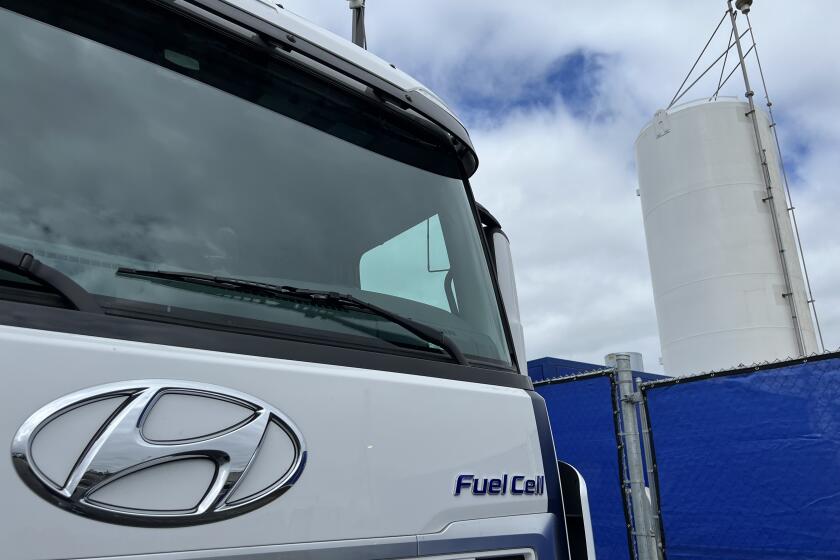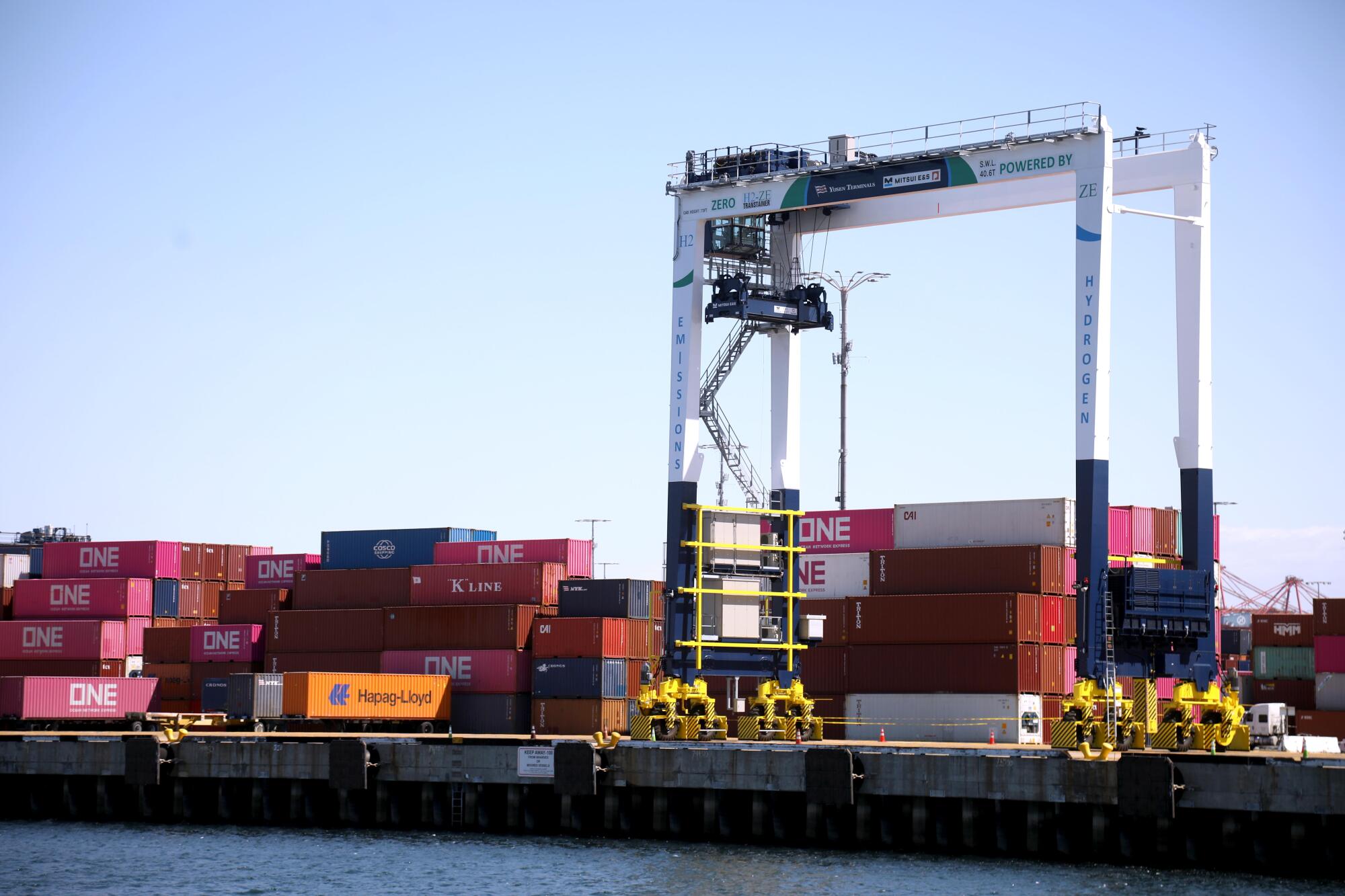
- Share via
To its most ardent supporters, the emergence of a “hydrogen economy” is nothing but wonderful: good for the climate, good for the environment, good for human health, good for the economy, good for jobs, good for the historically overlooked and disadvantaged members of society.
Is it?
California is about to find out.
Aggressive and impactful reporting on climate change, the environment, health and science.
The federal government plans to spend $7 billion to $8 billion to build a hydrogen economy in the U.S. The money will be allocated to seven regional “hydrogen hubs” across the U.S. mainland. Six cover multiple states. California gets a hub of its own — and $1.2 billion. Private investment would add $11 billion or so. The money will soon start flowing: A deal was signed with the U.S. Department of Energy in mid-July.
The deal creates a “public-private partnership” to run the hub, called ARCHES — the Alliance for Renewable Clean Hydrogen Energy Systems. The operation will disburse money for projects around the state. Hydrogen producers, oil companies, gas companies, green energy companies, environmental policy groups, long-haul trucking companies and fuel cell makers are among the applicants. Southern California Gas Co. already has announced plans to build a dedicated clean hydrogen pipeline in the L.A. region called Angeles Link.
The program will kick off with 37 projects — yet to be announced — spread across the state with a heavy concentration in the Central Valley.
What is a hydrogen hub?
That’s a lot of money, bureaucracy and infrastructure — so what exactly does California get when it gets a hydrogen hub?
Consider an analogy — the gasoline supply chain. Oil is refined into gasoline, the gasoline is shipped by truck or pipeline, and end users burn it to produce energy. A hydrogen hub would act much the same, but with far lower levels of climate-disrupting greenhouse gases — ideally.
Hydrogen is not expected to replace all fossil fuels, not even close — the state wants electricity to pick up most of that load. But electricity won’t work in some industrial sectors, and hydrogen could fill some of those gaps.
The idea is to seed the market with government money, set regulations that require reduction in greenhouse gases and create demand (currently close to nonexistent) and hope that a new technology or industry can scale up enough to dramatically reduce costs and prices.
Hydrogen is the most abundant element in the universe, and a powerful energy source. (The sun is mostly hydrogen.) When burned, unlike carbon-based molecules, hydrogen gives off no greenhouse gases.
It’s the leading candidate to address hard-to-decarbonize energy sectors that are difficult or impossible to run on electricity. Topping the list: long-haul trucking, steel making, glass making, cement making, heavy cargo handling equipment, large aircraft and ocean-going vessels. With some equipment modification, it could even be swapped for natural gas at electricity-generation plants.
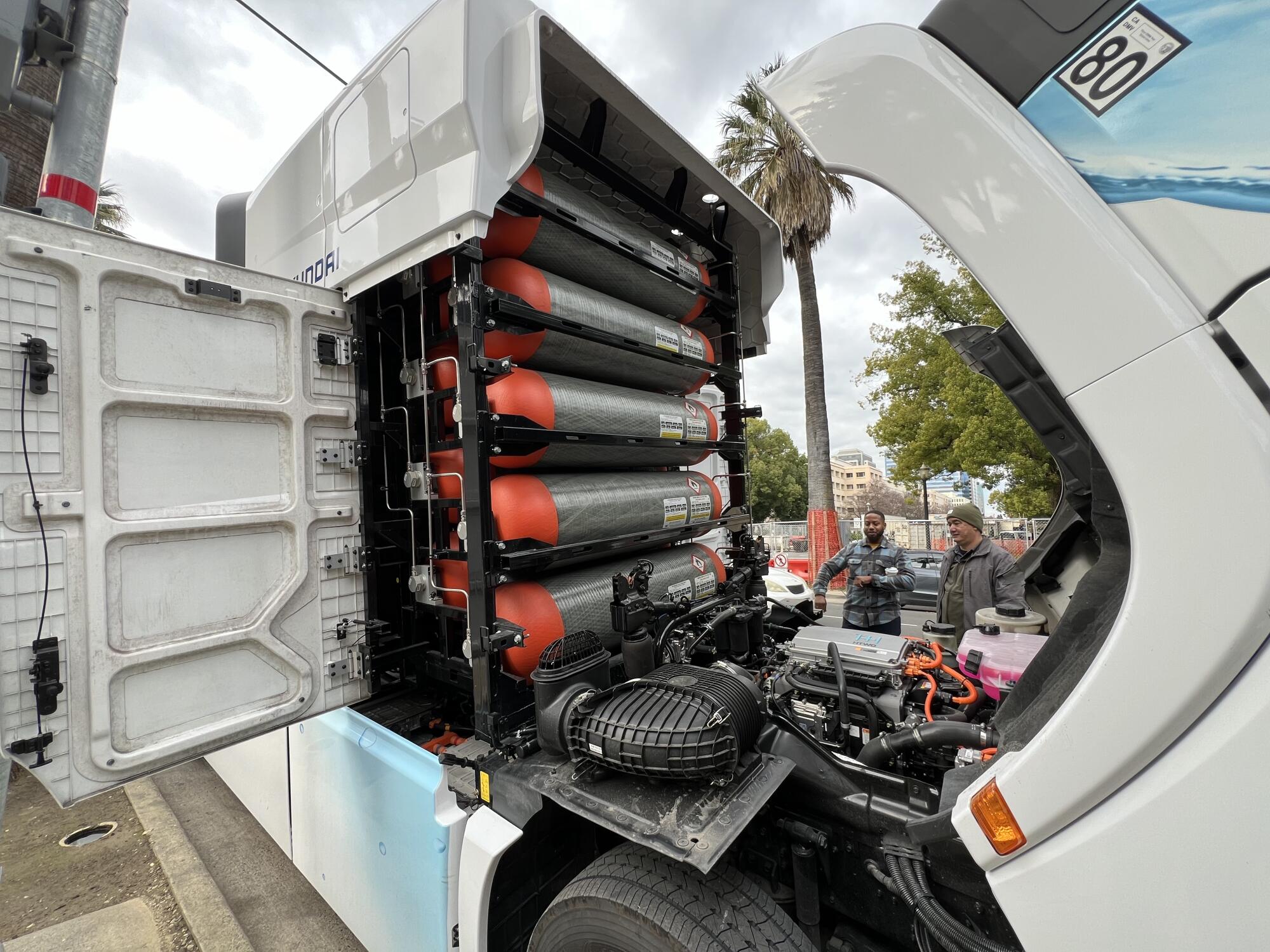
The big problem: Making clean or green hydrogen costs a lot of money, far more than the market can currently bear. “It is expensive to produce, expensive to transport, expensive to store, expensive to distribute and expensive to use,” said Michael Liebreich, a managing partner at clean energy investment firm EcoPragma Capital and a fixture at clean energy conferences around the world.
The hydrogen hubs’ main aim? A dramatic reduction in hydrogen’s cost and the creation of new markets for the stuff. Federal and state money will be used as leverage to attract private industry and finance the creation of a new infrastructure, scaling it up to get costs down while subsidizing the price for end users until it becomes affordable without taxpayer help.
Hydrogen markets aren’t new. A big international market for affordable hydrogen, in place for decades, trades about 95 million tons a year. Hydrogen feedstock is used to create ammonia for fertilizer and other products, and to help refine oil into gasoline, diesel and other fossil fuels. But making those millions of tons is a dirty, fossil-fuel-heavy game.
“Making” is a loose term. Hydrogen, of course, already exists. But it’s largely inaccessible on its own. Except for some scarce underground deposits, pure hydrogen must be coaxed out of other molecules.
The hydrogen atom — one proton, one electron — loves to hook up with other elements. Hydrogen is an ingredient in molecular matter including methane, vegetable fats salt water, drinking water and waste water. H₂O, right?
It’s also an essential component of hydrocarbons like oil and natural gas. Without the carbon, though, it’s as clean as an energy source can get.
Pulling it apart from its partners and isolating it for industrial use only recently has begun to move from dirty to clean. Currently, nearly all hydrogen production requires high heat and methane, the prime constituent of natural gas. Water is heated to steam and mixed with methane to produce hydrogen and carbon dioxide. That process typically costs between $1 and $2 per kilogram.
California is the second-largest user of this so-called gray hydrogen in the U.S., said ARCHES Chief Executive Angelina Galiteva.
The budding clean hydrogen industry has come up with a color scheme to identify the dirty process known as methane steam reformation and make it easier for the general public to understand cleaner alternatives.
The dirty way is called gray hydrogen. The cost ranges from 98 cents to $2.93 per kilogram, according to new-energy market researcher BloombergNEF.
But cleaner production methods are identified with other colors: blue, green, even pink. Eventually, they’ll have to compete with gray hydrogen on costs, or government subsidies will need to continue forever.
Blue hydrogen uses the gray methane method, but rather than letting carbon dioxide escape, the greenhouse gas is captured and stored. BloombergNEF estimates current costs between $1.80 and $4.70 per kilogram.
Green hydrogen employs a completely different production method, called electrolysis. The only ingredient is water. A massive machine pushes heavy currents of electricity through the water to split the molecules into their constituent elements, hydrogen and oxygen. If solar or wind (or nuclear) energy is used to power the electrolyzer, no carbon dioxide is emitted. The current cost of electrolytic green hydrogen, however, is steep: $4.50 to $12 per kilogram. (ARCHES will also fund projects that convert plant waste from forest floors and agricultural lands into hydrogen.)
Pink hydrogen is made using electricity produced by nuclear power, with no carbon emissions.
The hydrogen hubs will be funded to create the infrastructure for all three: blue, green and pink, with some regions specializing in a color or two. For California, the color is green.
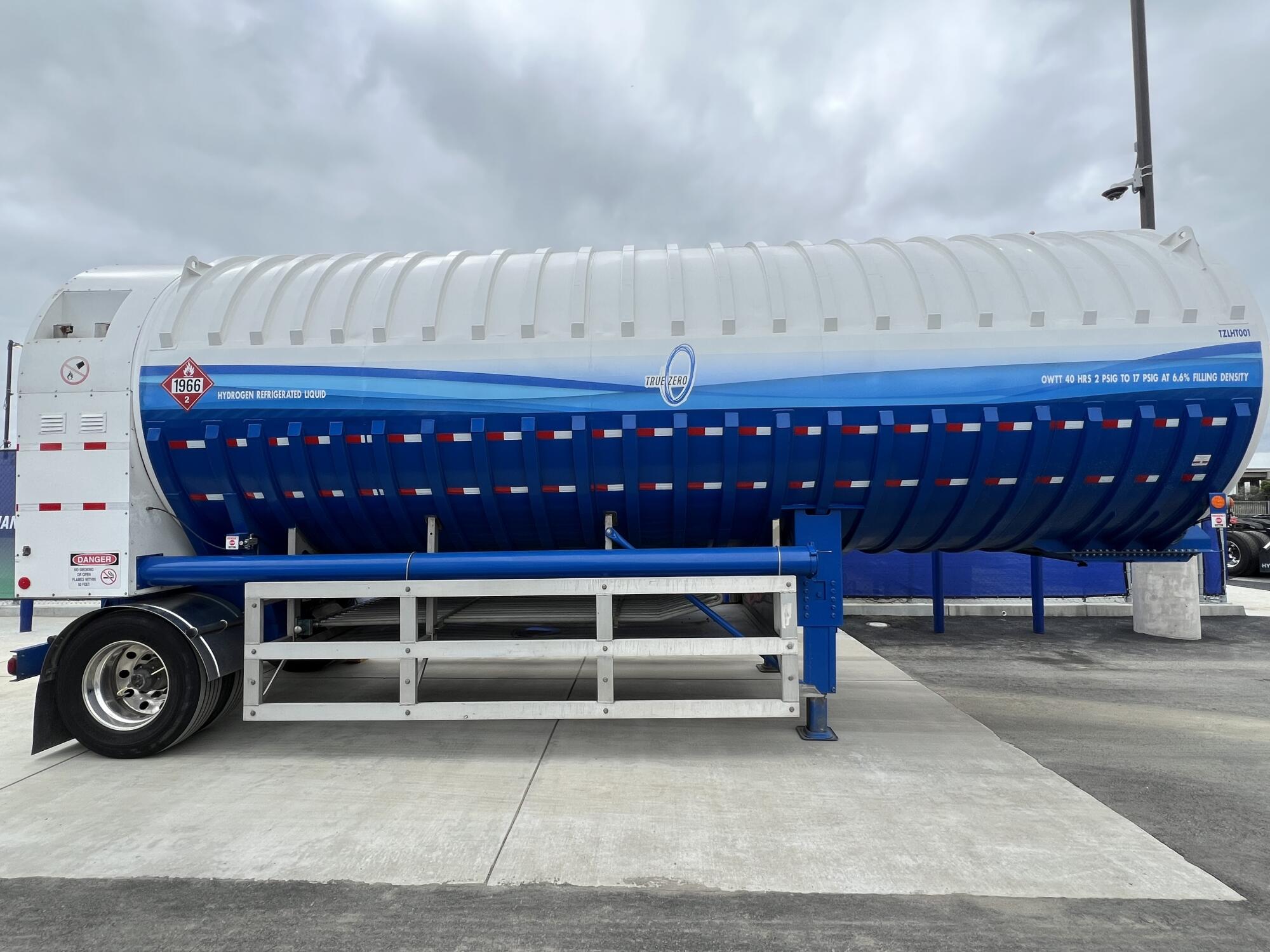
Environmental and other concerns
Cost is hardly the only challenge facing the hydrogen hubs. Hundreds of miles of pipelines must be constructed, new trucks powered by hydrogen assembled, hydrogen fueling stations placed along highways, and hydrogen storage units built.
Several environmental groups have come out against them, especially the hubs focused on blue hydrogen, which their foes consider a sop to the fossil-fuel industry with high potential for carbon dioxide leaks.
Even green hydrogen has drawn opposition from some who say it makes little sense to redirect an electric utility’s solar and wind power away from existing customers to make hydrogen, leaving those customers with dirtier alternatives. Those critics want the hydrogen industry to build its own clean electricity generators.
The U.S. Department of Treasury is reviewing the rules around hydrogen tax credits that could have a huge impact on the budding industry. Will credits apply to green hydrogen producers that tap into existing solar projects (thus competing with residential and other industrial users), or must they use new, dedicated solar plants? Will producers of green hydrogen get full credit only when renewable energy is online, or will they be allowed to mix in some dirtier stuff when renewables aren’t readily accessible?
Environmental groups and industry players eagerly await the decision. The tax credits could be worth hundreds of billions of dollars across the seven hydrogen hubs, according to climate economist Danny Cullenward.
Seven hydrogen hubs are planned throughout U.S., creating networks of production plants, trucks, pipelines. California is first to start using federal funds.
The Environmental Defense Fund believes clean hydrogen is important for hard-to-decarbonize industries. It generally supports green hydrogen, but with caveats.
The tiny size of hydrogen atoms and molecules (hydrogen atoms tend to link themselves into couples to create the molecule H2) makes them especially prone to leaks from pipelines and other containers, said Katelyn Roedner Sutter, the EDF’s representative in Sacramento. “Hydrogen is very small and slippery, and it leaks really easily and can leak anywhere,” she said. While hydrogen is not a greenhouse gas, she points out, it can still play an indirect role in damaging the atmosphere because it can react with other compounds.
Water is also an issue in drought-prone California. “There are certainly questions about where the water is going to come from,” she said.
Green hydrogen “certainly has potential” she said. “All of these details matter.”
Galiteva, the CEO of ARCHES, said leakage issues will be addressed, and the water problems too — with details to come later. But she’s “very perplexed” about environmentalists’ opposition. “We’re going to be decarbonizing the most polluting of all sectors — transportation, heavy industry, airplanes, shipping,” she said. “It’s like being against motherhood and apple pie to be against green hydrogen.”
ARCHES is not a government body; it’s a nonprofit company, registered as a private limited liability corporation. It’s owned by four partners: The University of California Board of Regents; the California Governor’s Office of Business and Economic Development; the State Building and Construction Trades Council of California; and the Renewables 100 Policy Institute.
Galiteva, Renewables 100’s co-founder, said ARCHES estimates the California hub will create 220,400 jobs, with high priority given to union labor. Health-wise, ARCHES claims that by 2031, $2.95 billion will be saved in health-related costs each year, as diesel fuel use declines. And $380 million will be invested in disadvantaged communities, including workforce development.
But first, hubs must reduce sky-high costs for clean hydrogen while boosting what’s now virtually nonexistent demand. That kind of cost reduction is aggressive, even audacious, for a government project. “The timeline is ambitious,” Galiteva said. “Our goal is to get it to $2 per kilogram” at wholesale prices. “If we can get it to $5 we can make it cost competitive with diesel fuel at the pump.”
California’s few hydrogen stations now charge up to $36 per kilogram. Precise comparisons with diesel or gasoline are difficult and depend on use. But fuel for a trip from Los Angeles to San Francisco in a Toyota Mirai or Hyundai Nexo fuel cell car would cost about twice as much as the same trip in a gasoline car. (The two Japanese automakers partially subsidize fuel costs when they lease the cars to Californians.)
The U.S. is hardly the only country attempting to build a hydrogen economy. China, Japan, South Korea, several countries in Europe, and Saudi Arabia are all sinking hundreds of billions into their efforts. More than 40 countries have developed national hydrogen strategies, according to the International Energy Agency. All face similar cost challenges.
Clean hydrogen will require massive spending on clean electrical power. Renewable power plants need to be built, transmission lines strung, electric substations upgraded or newly constructed, just to accommodate hydrogen production. That’s on top of the electric grid infrastructure already under strain and with new demands from electric vehicles and artificial intelligence server farms.
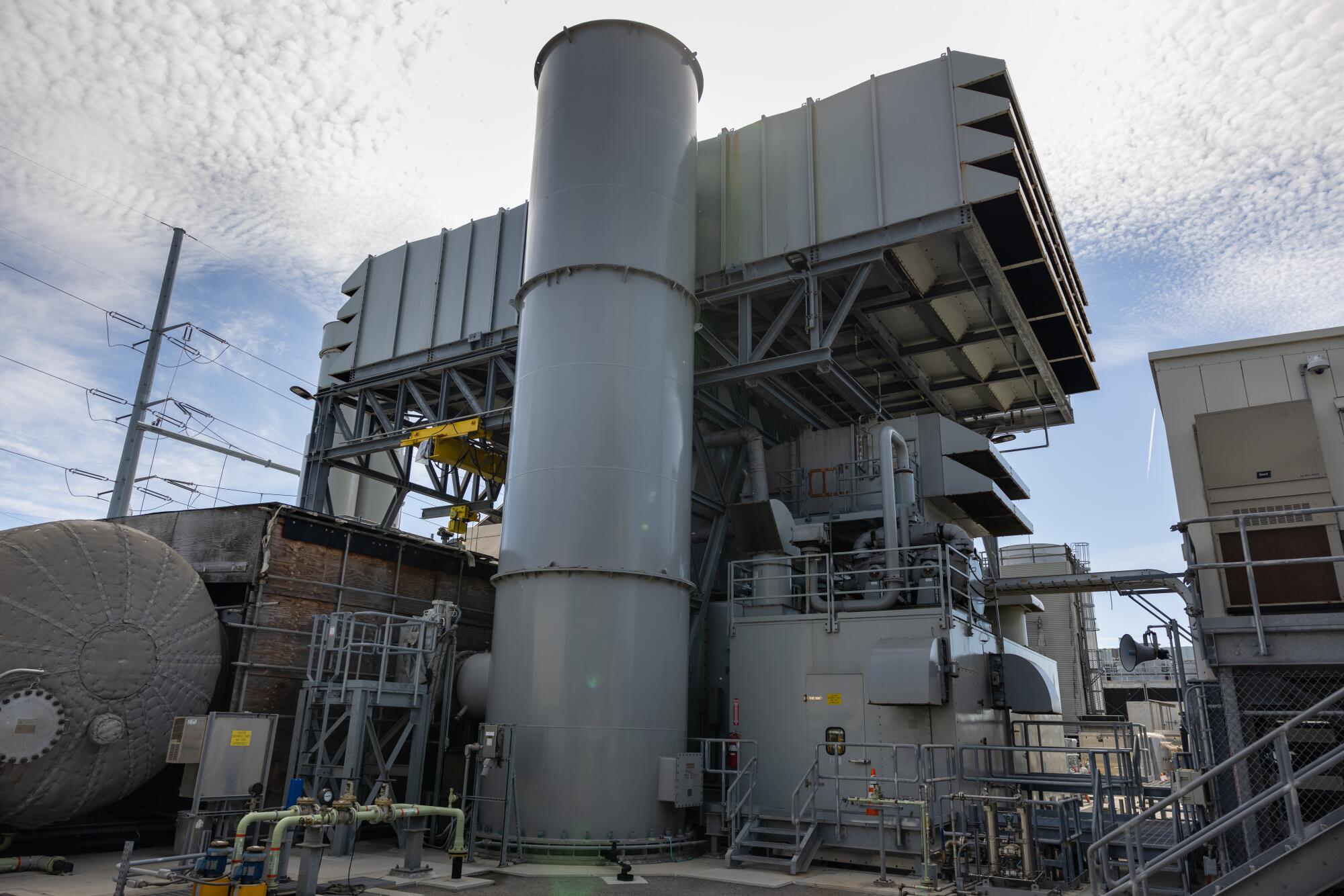
The road ahead for California
To provide the amount of clean hydrogen needed to meet California’s 2045 climate goals, the state’s production must grow dramatically, according to ARCHES — from 6.8 million tons annually in 2023 to 71 million tons in 2045.
Rapid price reduction has worked in renewable energy. Can it work for clean hydrogen? “We did it with wind and solar, and we need to do it with hydrogen as well,” said state Sen. Anna Caballero, whose district covers a wide swath of rural territory west of Merced and Fresno.
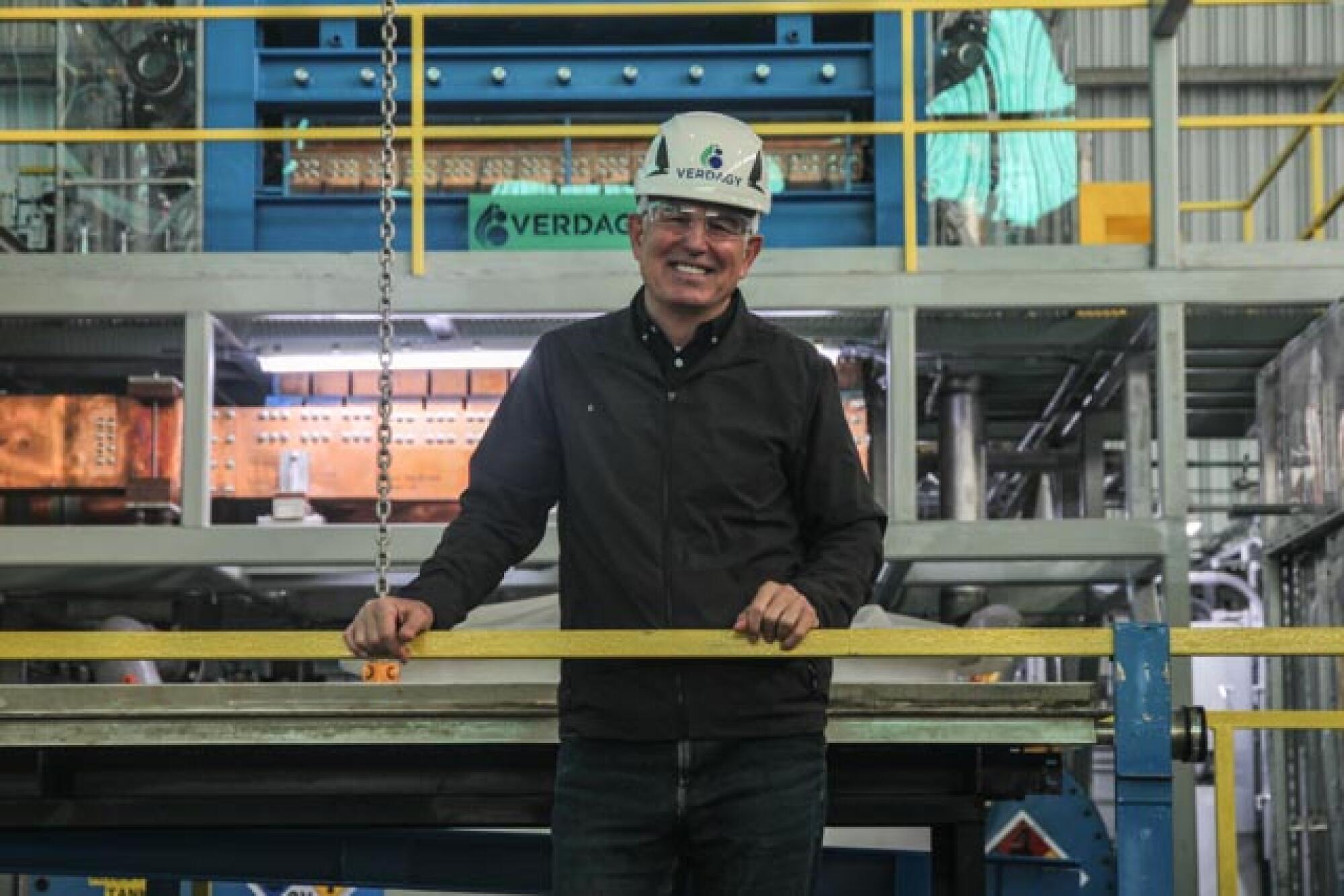
Galiteva and other hydrogen proponents point out that early solar power skeptics were proved wrong and that costs have plummeted consistently over time. That’s due mainly to increasing manufacturing experience, better understanding of materials, and scale. But that took decades. The hydrogen hubs aim to reduce costs dramatically in less than 10 years.
Green hydrogen production, for example, requires expensive industrial-size electrolyzers to split water. The basic technology is almost as old as the electric battery. Whether the equipment can be built affordably at scale is yet to be proved.
For the record:
10:32 a.m. July 25, 2024A previous version of this article reported that Verdagy is based in Morro Bay. It is based in Moss Landing.
“We’re in the early days of green hydrogen electrolysis,” said Marty Neese, chief executive at electrolysis startup Verdagy in Moss Landing, Calif.
Blue hydrogen has its own cost issues. It requires vast underground real estate. Both will require new pipelines to ship the gas where it’s needed. Trucks won’t cut it in the long run — even compressed hydrogen gas would require 20 tanker trucks to transport the same amount of energy that a single truck with a load of diesel fuel can deliver.
On top of all that, the permitting process and local opposition to industrial development, with all the lawsuits that entails, can be added to the list of challenges.
But if it works, by the middle of this century, thousands of diesel-powered semis will be replaced with quieter, cleaner hydrogen trucks. Steel, glass and other essential products can be produced spewing far less planet-warming, health-damaging pollution. Perhaps even commercial aviation could see a clean revolution. To the federal government and the state of California, that future is worth a multibillion-dollar bet.
Meanwhile, Southern California air regulators are reevaluating the region’s plans to reduce pollution in an attempt to avoid severe economic sanctions.

